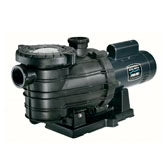Pool Paint
Types of Pool Paint

- From: $61.82
- Service Life: Up to 8 years
- Coats Required: 1
Coatings & Accessories
How-To Paint Your Pool
- Choose the correct coating for your pool type. If your pool is already painted, you must repaint your pool with the same type of paint coating in order for the paint to adhere properly. More information on selecting a pool coating and determining the composition of a current coating below.
- Prep the Pool Surface. This step is very important! Your new coating will not adhere to even the slightest oily residue such as suntan lotion, body oils, hair spray, algae or anything that comes between the pool surface and the new coating. Wash your pool to remove any existing oil residue. Never use a soap-type detergent because it leaves a soapy film on the surface. The best washing compound solution is TSP (tri-sodium phosphate).
- Scrub the Surface. Firmly scrub the pool surface; scrub the walls first and the floor last. Rinse off the residue with clear water immediately after scrubbing. Acid etching is required on bare masonry surfaces like concrete or plaster. It is also effective for removing chalky residue and hard mineral deposits on a previously coated pool. Acid washing opens tiny pores which allow the new coating to penetrate, thus creating a secure cohesive bond. Even on previously coated pools, an acid wash is recommended.
- Apply the Paint Correctly. Paint using a 3/8” nap roller. You will always want to start in the deep end, work your way towards the stairs and don’t paint yourself into a corner. It is best to paint in the morning in cooler temperatures.
- Be Patient! Proper curing time is very important to ensure your pool is ready for filling. Never fill your pool before it has had enough time to properly cure. Check the paint label to be sure, but typically at least 4-5 days is sufficient.

Choosing the Correct Coating
Using the right pool paint is is critical to ensuring that your pool paint will actually last. Typically when you paint the walls of your home, any paint will do the trick. That is not the case with pool paint. The surface of what you are painting is the most important thing to consider when painting your new pool.

Concrete Pool Paint
Concrete pools are the easiest since almost all pool paints will work. Your only decision is the quality of the paint. Acrylic enamel (2–3 year lifespan), synthetic rubber or chlorinated rubber (2–3 year lifespan), or epoxy (5–8 year lifespan) will all work with new concrete pools. Each have unique advantages, however epoxy paints will always offer the longest life.

Bare Plaster or Marcite Pool Paint
Again, most all pool paint products can be used, with epoxies offering the best long term investment. If the existing surface is rough, prime first with Gunzite. If smooth, prime first with Poxoprime II before application of Poxolon 2 or Zeron finish coat.

Fiberglass Pool Paint
The epoxy system is the best choice for fiberglass pools. First using a Gunzite primer, apply either two coats of Poxolon 2 or one coat of Zeron.

Steel or Aluminum Pool Paint
Epoxy paint is your choice for steel and aluminum pools. Both of these surfaces require a special primer before the application of the finish coat.
Why is pool paint different than other paints?
Pool paint, as its name suggests, is a type of paint designed specifically for swimming pools. It is specially formulated to withstand the harsh chemicals used in pool maintenance, such as chlorine, saltwater, and UV rays. Pool paint typically contains high-grade resins, pigments, and additives that help it adhere to concrete, plaster, and other pool surfaces, reducing the need for frequent repainting.
There are two main types of pool paint: epoxy and rubber-based. Epoxy pool paint is the most durable and long-lasting, providing a hard, glossy finish that resists fading, chalking, and staining. It is also resistant to abrasion and impact, making it ideal for high-traffic areas like decks and steps. Rubber-based pool paint, on the other hand, is more flexible and forgiving, making it a good choice for pools that are prone to cracking or shifting. It also offers a more matte finish that can be less slippery than epoxy.
When choosing pool paint, there are several factors to consider, such as the type of pool surface, the climate, and the amount of use the pool receives. Some pool paints are designed for specific types of surfaces, such as concrete or fiberglass, while others can be used on multiple substrates. It's also important to choose a paint that is compatible with the chemicals used in pool maintenance, as well as the local climate and weather conditions.
Overall, pool paint is a vital component in keeping your swimming pool looking and functioning its best. With its durability, resistance to chemicals and weather, and versatility, it is the go-to option for pool owners looking to refresh and protect their pool surfaces.











